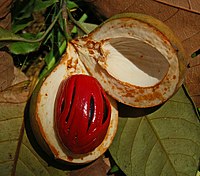
Photo from wikipedia
Environmental variation within a species' range can create contrasting selective pressures, leading to divergent selection and novel adaptations. The conservation value of populations inhabiting environmentally marginal areas remains in debate… Click to show full abstract
Environmental variation within a species' range can create contrasting selective pressures, leading to divergent selection and novel adaptations. The conservation value of populations inhabiting environmentally marginal areas remains in debate and is closely related to the adaptive potential in changing environments. Strong selection caused by stressful conditions may generate novel adaptations, conferring these populations distinct evolutionary potential and high conservation value under climate change. On the other hand, environmentally marginal populations may be genetically depauperate, with little potential for new adaptations to emerge. Here, we explored the use of ecological niche models (ENMs) linked with common garden experiments to predict and test for genetically determined phenotypic differentiation related to contrasting environmental conditions. To do so, we built an ENM for the alpine plant Silene ciliata in central Spain and conducted common garden experiments, assessing flowering phenology changes and differences in leaf cell resistance to extreme temperatures. The suitability patterns and response curves of the ENM led to the predictions that: 1) environmentally marginal populations experiencing less snowpack and higher minimum temperatures would have delayed flowering to avoid risks of late-spring frosts; 2) those with higher minimum temperatures and greater potential evapotranspiration would show enhanced cell resistance to high temperatures to deal with physiological stress related to desiccation and heat. The common garden experiments revealed the expected genetically based phenotypic differentiation in flowering phenology. In contrast, they did not show the expected differentiation for cell resistance, but these latter experiments had high variance and hence lower statistical power. The results highlight ENMs as useful tools to identify contrasting putative selective pressures across species ranges. Linking ENMs with common garden experiments provides a theoretically justified and practical way to study adaptive processes, including insights regarding the conservation value of populations inhabiting environmentally marginal areas under ongoing climate change.
Journal Title: Global change biology
Year Published: 2022
Link to full text (if available)
Share on Social Media: Sign Up to like & get
recommendations!